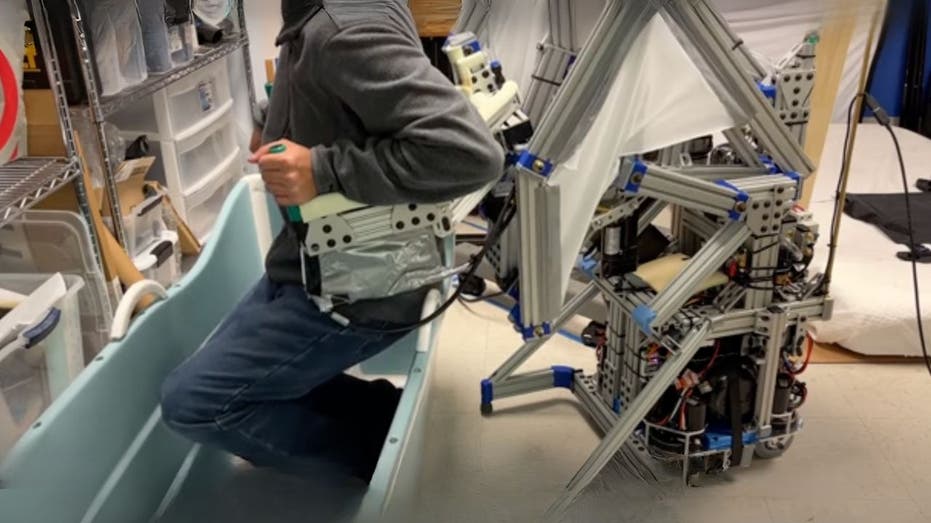The demographic landscape in the U.S. is shifting rapidly, with the median age now at 38.9, almost a decade older than it was in 1980.
By 2050, the population of adults over 65 is projected to surge from 58 million to 82 million, intensifying the already urgent challenge of eldercare. With falls remaining the top cause of injury among older adults, the need for innovative, tech-driven solutions has never been clearer.
MIT engineers are stepping up to this challenge with E-BAR, a mobile robot designed to physically support seniors and prevent falls as they move around their homes.
E-BAR, short for Elderly Bodily Assistance Robot, is not your typical assistive device. Rather than relying on harnesses or wearables, which many seniors find cumbersome or stigmatizing, E-BAR operates as a set of robotic handlebars that follow users from behind. This allows individuals to walk freely, lean on the robot’s arms for support or receive full-body assistance when transitioning between sitting and standing. The robot’s articulated body, constructed from 18 interconnected bars, mimics the natural movement of the human body, delivering a seamless and intuitive experience.
AI ROBOTS HELP NURSES BEAT BURNOUT AND TRANSFORM HOSPITAL CARE
The engineering behind E-BAR’s mobility is equally impressive. The robot’s 220-pound base is meticulously designed to support the weight of an average adult without tipping or slipping, and its omnidirectional wheels enable smooth navigation through tight spaces and around household obstacles. This means E-BAR can move effortlessly alongside users, providing support in real time, whether they are reaching for a high shelf or stepping out of a bathtub.
BEST CREDIT CARDS FOR SENIORS AND RETIREES 2025
What sets E-BAR apart from previous eldercare robots is its integrated fall-prevention system. Each arm is embedded with airbags made from soft, grippable materials that can inflate instantly if a fall is detected. This rapid response cushions the user without causing bruising, and, crucially, it does so without requiring the user to wear any special gear. In lab tests, E-BAR successfully supported elderly volunteers as they performed everyday tasks that often pose a risk for falls, such as bending down, stretching up or navigating the tricky edge of a bathtub.
Currently, E-BAR is operated via remote control, but the MIT team is already working on automating its navigation and assistance features. The vision is for future versions to autonomously follow users, assess their real-time fall risk using machine learning algorithms and provide adaptive support as their mobility needs evolve.
WHAT IS ARTIFICIAL INTELLIGENCE (AI)?
TOP TABLETS FOR SENIORS: EASY, DISTRACTION-FREE AND WI-FI OPTIONAL
The E-BAR project is rooted in extensive interviews with seniors and caregivers, which revealed a strong preference for unobtrusive, non-restrictive support systems. E-BAR’s U-shaped handlebars leave the front of the user completely open, allowing for a natural stride and easy exit at any time. The robot is slim enough to fit through standard doorways and is designed to blend into the home environment, making it a practical addition rather than an intrusive medical device.
MIT researchers see E-BAR as part of a broader ecosystem of assistive technologies, each tailored to different stages of aging and mobility. While some devices may offer predictive fall detection or harness-based support, E-BAR’s unique combination of full-body assistance, fall prevention and user autonomy addresses a critical gap for those who want to maintain independence but need occasional support.
HOW VR TECHNOLOGY IS CURING LONELINESS IN SENIORS
Currently, MIT’s E-BAR robot is still in the prototype stage and is not yet available for consumer purchase. The research team is continuing to refine the design and aims to bring it to market in the coming years, but it could take 5–10 years before the device receives full regulatory approval and becomes commercially accessible.
Looking forward, the research team is also focused on refining E-BAR’s design to make it slimmer, more maneuverable and even more intuitive to use. They are also exploring ways to integrate advanced AI for real-time fall prediction and adaptive assistance, ensuring that the robot can meet users’ changing needs as they age. The ultimate goal is to provide seamless, continuous support, empowering seniors to live safely and confidently in their own homes.
SUBSCRIBE TO KURT’S YOUTUBE CHANNEL FOR QUICK VIDEO TIPS ON HOW TO WORK ALL OF YOUR TECH DEVICES
BEST FATHER’S DAY GIFTS FOR EVERY DAD
What stands out about E-BAR is how it’s designed with real people in mind, not just as a tech gadget. It’s easy to see how something like this could make a big difference for seniors wanting to stay independent without feeling tied down by bulky or uncomfortable devices. As the technology improves, it could change the way we think about caring for older adults, making everyday life safer and a bit easier for everyone involved.
How comfortable would you feel trusting a robot like E-BAR to help your loved ones move safely around their home? Let us know by writing us at Cyberguy.com/Contact
For more of my tech tips and security alerts, subscribe to my free CyberGuy Report Newsletter by heading to Cyberguy.com/Newsletter
Ask Kurt a question or let us know what stories you’d like us to cover.
Follow Kurt on his social channels:
Answers to the most-asked CyberGuy questions:
New from Kurt:
Copyright 2025 CyberGuy.com. All rights reserved.
